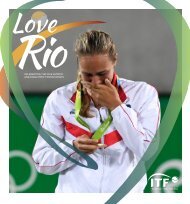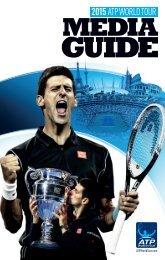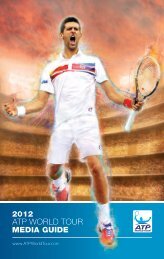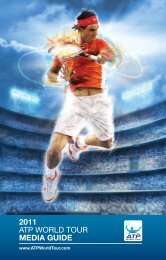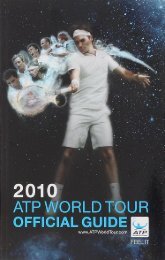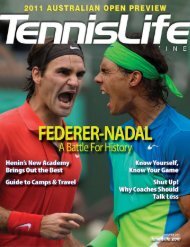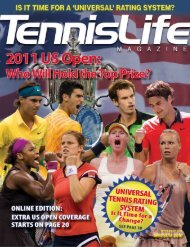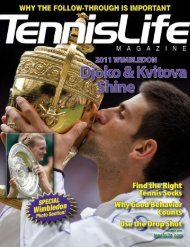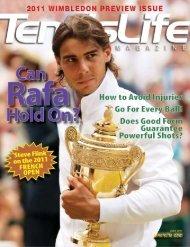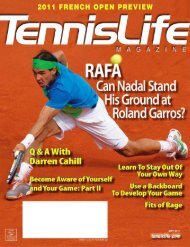A Champion's Mind - Pete Sampras
www.tennismoscow.me Insta:TENNISMOSCOW
www.tennismoscow.me Insta:TENNISMOSCOW
Create successful ePaper yourself
Turn your PDF publications into a flip-book with our unique Google optimized e-Paper software.
The European clay-court season had been a disaster, the <strong>Pete</strong> Fischer scandal had thrown me for a loop,<br />
and Jonas Bjorkman of Sweden had bounced me out of the big Queen’s Club tournament. But Wimbledon .<br />
. . Wimbledon was a different story. It had become a place of refuge for me, and I really needed that in<br />
’97.<br />
I rolled through my first three opponents at Wimbledon, giving up an average of a shade over ten games<br />
per five-set match, meaning I was winning three games to one against my average opponent. Although I<br />
had struggled on grass in the past and would struggle on it again in the future, in 1997 the game just felt . .<br />
. easy. It felt so easy that when I beat my rival, Wimbledon hero Boris Becker, in the quarterfinals, he<br />
made a surprising declaration up at the net when we shook hands. He told me he had just played his last<br />
Wimbledon final—he was retiring.<br />
I was stunned by that; I had no idea he was even considering it, although by then he was slightly past his<br />
prime. I learned later that it was just his emotions getting the better of him; apparently, I had played such a<br />
commanding match that he figured, “Why bother?” I was happy when, come 1998, he changed his mind<br />
and was back at Wimbledon.<br />
Wimbledon is a place full of complex rituals and traditions, but the thing I most cherish about the<br />
tournament is the simplicity of tennis on grass. It’s easy and natural. It’s a no-frills undertaking played on<br />
a clean, elegant, quiet stage. That remained true even after the “grass tennis is boring” debate led<br />
Wimbledon to slow the game by changing the balls and grass mix. Although that process was ongoing in<br />
the second half of my career, I hardly noticed. I played the same serve-based, attacking tennis from the<br />
beginning to the end of my Wimbledon career.<br />
I like that grass-court tennis is (or was) serve-based, and I’m not just saying that out of self-interest.<br />
Historically, the game was always serve-based—the serve is the most important stroke in tennis. It’s also<br />
the one over which you have total control, because the ball isn’t moving when you start your shot. The<br />
entire game, including the scoring system, is built around the idea that having the serve gives you a big<br />
advantage.<br />
It doesn’t matter how good your backhand or forehand is, there’s only one way to win a set or match.<br />
You have to break serve more often than you are broken. This is still true in the tiebreaker era given that<br />
the only way to win the tiebreaker is by scoring at least one “minibreak”—that is, winning at least one<br />
more point off your opponent’s serve than he gets off yours. It’s a bit of a shame that in this era of slower<br />
courts, great serving is not as well rewarded as it has been in the past, and that the coaches and players<br />
today overlook the extent to which a player with a great serve can build his entire game around the shot.<br />
To me, a match with a lot of service breaks is as unsatisfying as a match with none, because a great match<br />
is only supposed to have a handful of decisive moments (as entertaining as all the other points may be).<br />
It’s just like a book or movie is supposed to have just a handful of key scenes or plot twists.<br />
Although tennis on grass came easily to me, it was also mentally debilitating. I served and volleyed and<br />
returned, biding my time, trying to stay focused and positive. I tried to be ready for the moment when a<br />
little daylight came filtering through the crack in the door. Grass-court tennis between power players was<br />
often compared to a crapshoot. (In the 1991 Wimbledon semifinal between Michael Stich and Stefan<br />
Edberg, there was just one service break in the entire match, and the guy whose serve was broken, Stich,<br />
ended up winning the match! The scores were 4–6, 7–6, 7–6, 7–6.) But winning was anything but a roll of<br />
the dice. A better analogy is that grass-court tennis in my era was like an old-fashioned Western gunfight<br />
—you didn’t want to be the one to blink, tip your next move, or fumble as you dragged leather.<br />
On grass, momentum often shifted in the blink of an eye. No points anywhere else were big points in<br />
quite the way they were at Wimbledon, because you often got only two or three swings of the racket with<br />
which to win a set. At Wimbledon, a match might be determined by a sloppy second serve that leads to a<br />
service break early in the first or second set. You paid heavily for your mistakes on grass. Breaks were



